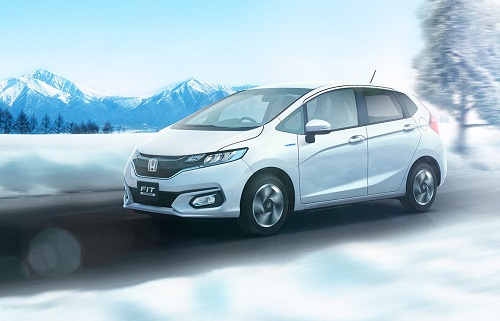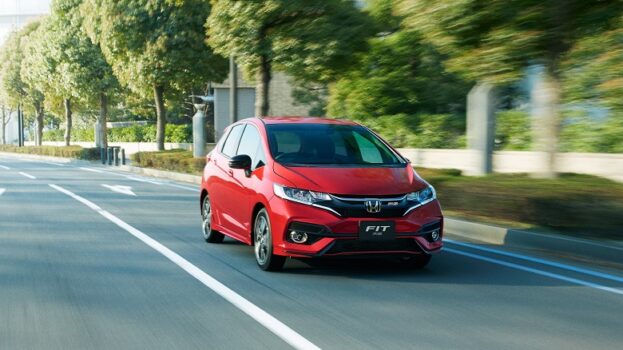Exhaust gas regulations and fuel efficiency standards are becoming stricter year by year, and each automobile manufacturer is making efforts to improve environmental performance and fuel efficiency in order to respond to them. In recent years, many new cars have excellent fuel efficiency that is incomparable to cars from a decade ago, but the current situation is that there is still a difference in fuel efficiency depending on the model. Therefore, it is important to carefully check the fuel consumption when choosing a car.
Fuel economy characteristics of the Fit
The current model Fit is the 3rd generation model that appeared in September 2013, but it has evolved into a style that makes you feel advanced and sporty by renewing the front and rear bumpers at the time of minor changes in 2017.
Originally, the Fit had a reputation for fuel efficiency, but the powertrain was also modified during the minor change.
A 1.3L Atkinson cycle DOHC i-VTEC engine that achieves both low fuel consumption and high output, which is the basis of the Fit, and a 1.5 that uses Honda’s unique direct injection technology to achieve powerful driving and an exhilarating driving feel with overwhelming power. The L direct-injection DOHC i-VTEC engine and the hybrid system “SPORT HYBRID i-DCD” that selects the most efficient mode from the three driving modes according to the driving situation. Tuning has been applied to further improve the fun of driving, such as further fuel efficiency and smooth acceleration.
In addition to improving the powertrain, fuel efficiency has also been improved by changing the shape of the front pillars and front bumper spoiler, taking into consideration aerodynamic resistance.
Fit’s Catalog Fuel Efficiency
The Fit has three powertrains, a 1.3L petrol car, a 1.5L petrol car, and a 1.5L hybrid car, and all of them have two drive systems, 2WD and 4WD.
Fit’s JC08 mode catalog fuel economy is as follows.
・1.3L petrol car
| grade | Drive system | transmission | fuel consumption |
|---|---|---|---|
| 13G・F | 2WD | CVT | 24.6km/L |
| 5 MT | 21.8km/L | ||
| 4WD | CVT | 20.2km/L | |
| 13G・L Honda SENSING | 2WD | CVT | 24.6km/L |
| 4WD | CVT | 20.2km/L | |
| 13G・S Honda SENSING | 2WD | CVT | 24.2km/L |
| 4WD | CVT | 20.2km/L |
・1.5L petrol car
| grade | Drive system | transmission | fuel consumption |
|---|---|---|---|
| 15XL Honda SENSING | 2WD | CVT | 22.2km/L |
| 4WD | CVT | 19.4km/liter | |
| RS・Honda SENSING | 2WD | 6 MT | 21.0km/L |
| CVT | 19.2km/L |
・Hybrid vehicle
| grade | Drive system | transmission | fuel consumption |
|---|---|---|---|
| HYBRID | 2WD | 7DCT | 37.2km/L |
| 4WD | 7DCT | 29.4km/L | |
| HYBRID-F | 2WD | 7DCT | 34.0km/L |
| 4WD | 7DCT | 28.6km/L | |
| HYBRID・L Honda SENSING | 2WD | 7DCT | 34.0km/L |
| 4WD | 7DCT | 28.6km/L | |
| HYBRID-S Honda SENSING | 2WD | 7DCT | 31.8km/L |
| 4WD | 7DCT |
28.0km/L
|
Fit’s actual fuel consumption
According to e fuel consumption, which collects the actual fuel consumption data of the owner, the actual fuel consumption of the Fit is 15.31-16.32km/L for the 1.3L petrol 2WD vehicle, 15.26km/L for the 4WD vehicle, and 14.93-16.16 for the 1.5L petrol 2WD vehicle. km/L, 21.80-23.60km/L for hybrid 2WD vehicles, and 22.66km/L for 4WD vehicles.
We could not confirm the data for 1.5L petrol 4WD vehicles.
When checking the fuel efficiency performance, it is important to check not only the catalog fuel efficiency but also the actual fuel efficiency. In the first place, the catalog fuel efficiency is measured under certain conditions on a flat and straight road without using lights or air conditioners, so it can be said that it is a numerical value used as an index. However, since we drive in various places in our daily life, it is common for any car to have a difference between the catalog fuel consumption and the actual fuel consumption.
Actual fuel consumption varies depending on road conditions and driving methods, but in the case of JC08 mode fuel consumption, it is said that the actual fuel consumption is about 30% lower than the catalog fuel consumption, so the difference between the catalog fuel consumption and the actual fuel consumption of the Fit is For both powertrains, 2WD vehicles seem to be slightly above average, but 4WD vehicles are within the average range.
Fit ride
 Source: Honda “Fit” fuel economy and environmental performance
Source: Honda “Fit” fuel economy and environmental performance
I want my car to have a comfortable ride. When choosing a car, be sure to check the ride comfort as well.
Comfortable interior space brought about by quietness
HYBRID・S Honda SENSING adopts a front window glass with a sound insulation function and a sound absorbing floor undercover in addition to the UV protection function and the infrared protection function. By suppressing the intrusion of external sounds such as road noise and wind noise, excellent quietness has been achieved, resulting in a quiet and comfortable interior space.
Realizing a comfortable ride by increasing the rigidity of the body and optimizing the suspension
By increasing the rigidity of the body and optimizing the damping characteristics of the suspension dampers, we have achieved both excellent steering stability and a comfortable ride with little shaking.
Fit with excellent fuel efficiency for both hybrid and petrol vehicles
It can be said that one of the attractions of the Fit is that it has excellent fuel efficiency not only in hybrid vehicles but also in petrol vehicles.
Currently, vehicles with fuel efficiency that meet certain standards can receive tax relief measures for vehicles. When choosing a car, be sure to check fuel efficiency as well as design, driving performance, safety performance, etc.
*The content of the article is based on information as of September 2019.









